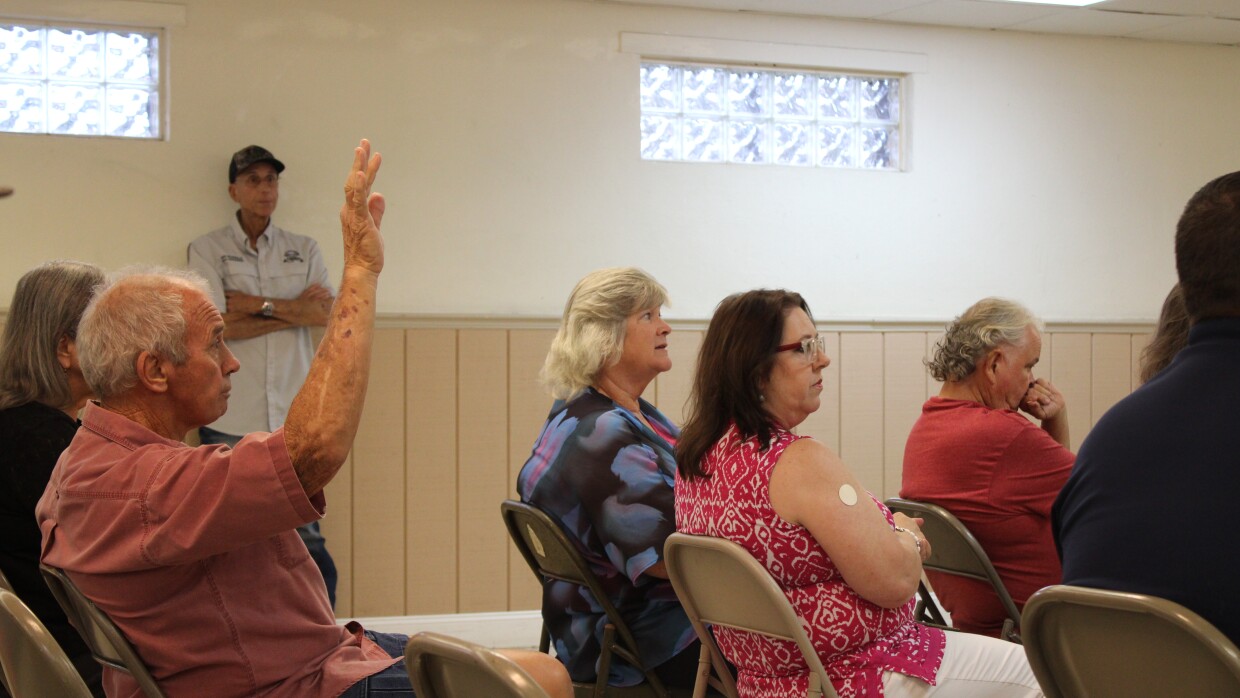In a city renowned for its water, there is something wrong with the air.
The smell starts around 6 a.m., when the coffee is brewing and the stray cats begin gathering near Linda Masi’s Lake Panasoffkee home in Sumter County, eager for breakfast.
She puts on a mask before stepping out to feed them as her husband pulls out of the driveway on the way to work.
Last year, Masi would’ve gone for a morning walk to stretch her legs before the day began. Her husband would’ve picked up Hardee’s breakfast for his coworkers and sipped scalding coffee along the drive.
But the “rotten, dead smell” that emerged in January makes Masi dizzy and turns her husband’s food “unappealing.”
It drives resident and recreational fisherman Bret Bartley off of the city’s namesake lake: a 5,000-acre rarity of spring-fed water, rarely deeper than four feet.
When the wind is right, the smell reaches nearby Sumterville, Bushnell and Nobleton, too, the “dirty diaper on an open campfire smell” as Tammie Sumner calls it, giving her migraines.
Neighbors report burning eyes, slipping property values and stench-steeped walls. They trace the smell to a sliver of land between Interstate 75 and U.S. Route 301, where a landfill, metal recycling business and compost plant sit side by side.
The three facilities have been there for years, prompting occasional odor complaints, but never of this scale.
Residents repeat the same questions in city council meetings and social media threads: What changed? What can be done to make it stop?
A waste processing trio
A steady stream of trucks rumbles along County Roads in Lake Panasoffkee at all hours of the day, shuttling everything from ash residue to treated sewage sludge to three places within a mile radius: Trademark Metals Recycling, Compost USA and the ACMS Heart of Florida Landfill.
The first collects, shreds and melts metals. The second combines treated sewage sludge known as biosolids with yard waste to create fertilizer. The third piles up everything else.
All three produce smells, mixing together into a cocktail of stench. Which facility is most responsible depends on who you ask.
The City of Bushnell, which has jurisdiction over the trio, has cited each facility for violating the city’s odor code. Bushnell staff issued Trademark Metals a notice of violation in April, a request for assistance in getting Compost USA into odor compliance in early June and a notice of intent to revoke the landfill’s operating permits later that month.
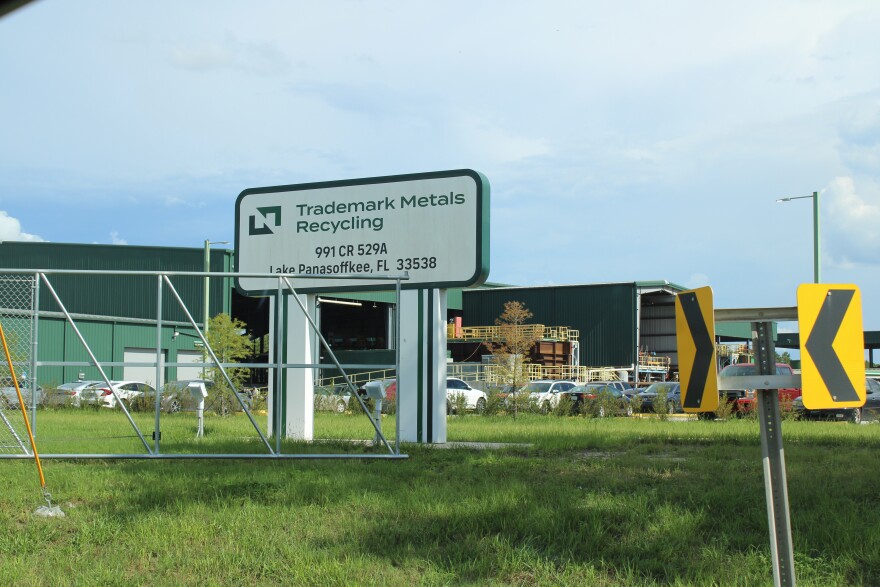
The Florida Department of Environmental Protection came to inspect the three sites in May and noted “offsite odors” at two: the metals recycling facility and the landfill.
The recycling center submitted evidence of controlling its dust and the agency deemed it in compliance with stormwater regulations by June.
The landfill’s case is more complicated.
As the only one of the three facilities classified as a “major source of air pollution” under the Clean Air Act, the landfill is subject to more stringent air quality requirements.
Investigations into its compliance are ongoing.
The Heart of Florida and backbone of waste disposal
The city limits of Bushnell look like Tetris blocks, its annexations making a geometric border around I-75. The city annexed the ACMS Heart of Florida landfill property in 2011, before any garbage trucks started their engines.
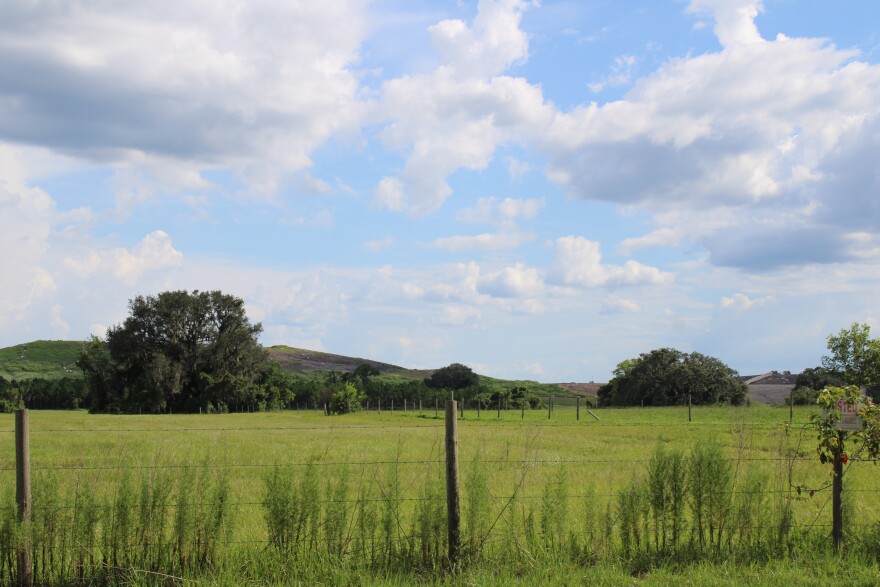
The private landfill began accepting trash in 2013 under a management team that included former Citrus County Sheriff and state Senator Charlie Dean and his son, Charlie Dean Jr.
As a municipal solid waste landfill, it accepted mostly household trash: food scraps, papers and anything else thrown into the trashcan. It also accepted construction and demolition debris, ash residue and ‘other wastes’: a category including autofluff, contaminated soil and biosolids.
In its first full year of operation, 2014, the landfill accepted about 230,000 tons of trash. By 2017, that number had more than doubled.
The following year, the Deans sold the landfill to Waste Connections: the third largest solid waste service in North America. In 2019, the landfill accepted three times the weight of the Empire State building in trash, distributed between four mounds.
It continues to grow.
The landfill currently operates seven waste mounds and is permitted by the FDEP to have up to 19. A life expectancy report submitted by the landfill this month estimate it’ll take about 37 years to reach capacity.
Landfill gas: a potential source of the stench?
The Heart of Florida Landfill is one of the largest in the state by total daily waste accepted. Lots of trash means lots of gas, which can be difficult and expensive to control.
A landfill’s hills may look static from the roadside, but a cascade of chemical reactions happen in their hot, jumbled underbelly.
Microorganisms munch on refuse, generating methane, carbon dioxide and other gases. “A dry pound of food waste would make more gas than a dry pound of paper, for example, or a dry pound of wood,” said solid waste engineering specialist Morton Barlaz, professor emeritus at North Carolina State University. Barlaz is not affiliated with Waste Connections but has received research funding from a foundation the company supports.
He said the difference in gas production happens because the chemicals that make up food waste and biosolids are easier for enzymes to access and break down than tough, cross-linked chemicals like lignin in wood.
As gases form, their light weight drives them upwards, squirming through soil until reaching the open air. Landfills are the third largest source of man-made methane emissions in the US, according to the Environmental Protection Agency.
Often, they’re also stinky.
The EPA requires landfills to install a system to vacuum out and burn gas with a flare once emissions reach about 37 tons annually. The Heart of Florida Landfill installed the first phase of its gas collection system and flare in 2018, before hitting the threshold, and routinely expands it.
The facility’s annual emissions surpassed the 37 ton limit in June, giving the site until December 2027 to submit a formal gas collection plan to the EPA and complete construction.
While drilling a gas collection well in December 2024, “we had an extra stinky event,” said Dan Gudgel, division landfill manager for Waste Connections in Florida. The drilling and the smell lasted for about three weeks.
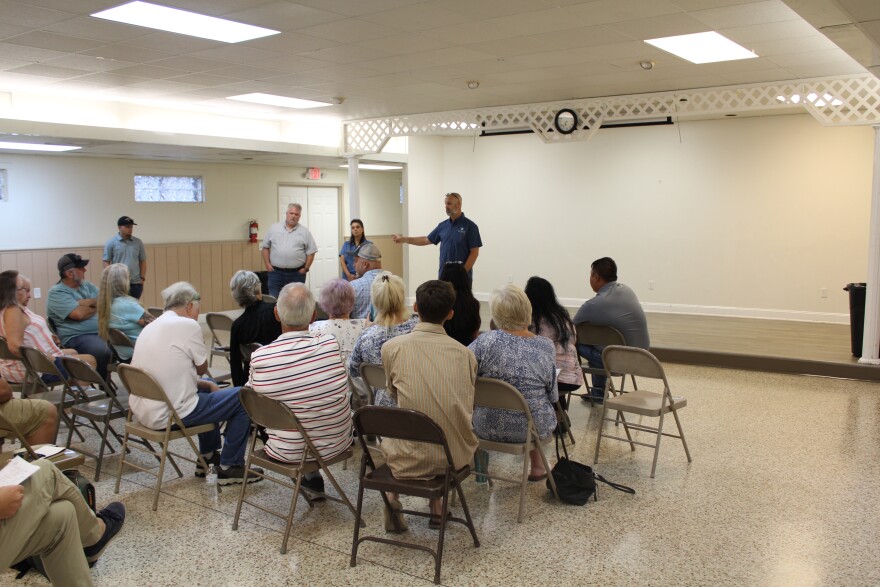
Gudgel attributed the smell to an extra potent area of trash, something that Barlaz said can happen if waste is especially fresh and active.
“It's possible that they tapped into some waste that was making a lot of gas,” Barlaz said. Another explanation could be if the crews had to turn off the system’s vacuum pressure to avoid pulling in too much oxygen during the drilling process, which can cause fires. “What was being smelled might not have been the gas coming out of that well,” Barlaz said, “it might have been the whole area that wasn't under vacuum.”
When drilling its next well in April, the company used a “backing box” to suck air back into the system during construction. “We identified an issue in December and we deployed a solution for that on the next drilling project,” Gudgel said. “We believe that was very effective.”
Perhaps more important than where the landfill has gas collection wells is where they don’t have them, said Barlaz.
“It takes at least two years from the time waste is buried before that gas is under collection and the regulations allow up to five years,” he said. “Even at landfills with a lot of gas collection wells, there is a part of the landfill at which there is no gas collection until the landfill is full and closed.”
“There's been some recent literature suggesting that most of the emissions are coming from that area,” Barlaz said. “At most sites, that’s the biggest source of odors.”
Sites complying with the state and federal landfill gas regulations may still be emitting substantial amounts of gas to the atmosphere, according to a study by researchers at the University of Florida.
Facilities can voluntarily reduce their emissions beyond requirements by, for example, installing horizontal, subsurface gas collection wells in active parts of the landfill where vertical wells aren’t practical.
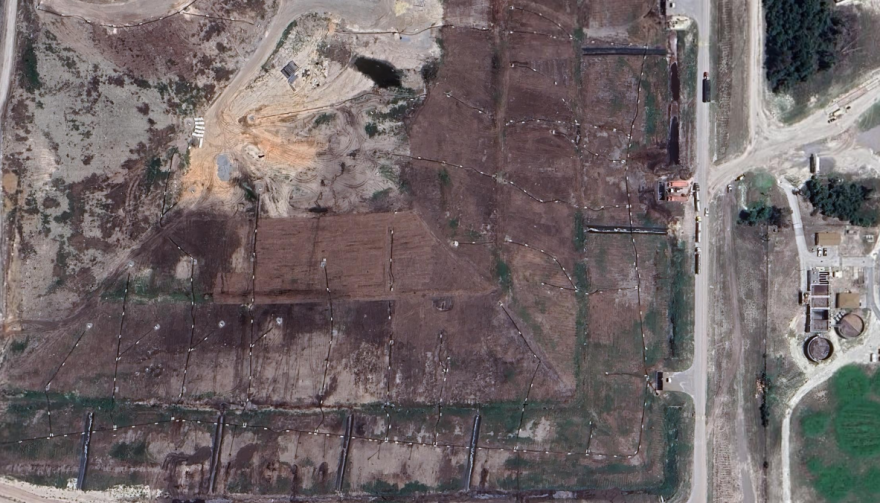
A change in processing ‘trash tea’
In addition to gases, landfills produce liquids.
When it rains, water sneaks into crevices in the landfill’s soil and continues its journey downward. It percolates through years of garbage, creating a sort of trash ‘tea’ before arriving at the landfill’s bottom: an impermeable plastic liner that prevents this ‘tea’, known as leachate, from entering the groundwater.
The Heart of Florida Landfill collects its leachate and does two things with it: trucks it away and evaporates it.
The former is the landfill’s longtime system. Crews transfer leachate into huge storage tanks, where it sits until trucks take it away for processing at a wastewater treatment facility.
Transportation is expensive and wastewater treatment facilities typically charge by volume to process the liquid, which can contain higher levels of forever chemicals known as PFAS than typical wastewater.
“Many landfills are trying to at least think about pretreating their leachate to reduce the PFAS or maybe reduce the volume of the leachate that they discharge to an offsite facility,” said Jiannan “Nick” Chen, whose team at the University of Central Florida analyzed how public landfills dispose of their trash-steeped liquid.
Chen’s study didn’t include private landfills, but he said they may be even more keen on on-site treatment because they often pay a fee to dispose of their leachate at city or county-owned facilities, compared to public landfills who do it for free or reduced cost.
The Heart of Florida Landfill hopped on the on-site treatment trend in February. Its leachate evaporator uses natural gas to heat the liquid until it funnels out as steam from the machine’s top, leaving behind a dry, condensed portion of chemicals that can be put back into the landfill.
Gudgel estimated the landfill currently evaporates about 30% of its leachate and transports the other 70% offsite. During a July 1 inspection, the FDEP confirmed the machine was operating correctly but noted “a strong objectionable odor emanating from the evaporator.”
Gudgel told neighbors during a July 24 community meeting that landfill staff “identified that piece of equipment as a potential source of odor,” and shut it down two weeks prior “to attempt to see if we can notice a difference.”
Barlaz said the odor could come from volatile organic compounds released into the air as the leachate evaporates. He described it as a jar full of water mixed with gasoline. If you were to blow air into the jar through a straw, the gas escaping from the jar would smell like gasoline.
Many chemicals present in landfill gas and leachate, such as hydrogen sulfide and ammonia, produce odors even in tiny amounts.
The landfill’s leachate evaporator can process about 60,000 gallons of liquid per day, but, before Gudgel’s team paused it, was only permitted by the FDEP to do about half of that.
How much the system evaporates is controlled by how much natural gas is used to heat it. The landfill exceeded its permitted fuel-flow limit on 31 days between March 27 and May 5, according to documents submitted to the FDEP.
“Upon confirming the exceedances, we immediately shutdown the leachate evaporator on May 6, 2025 and retrained staff on the data-conversion procedure and permit limits,” reads the letter. Landfill staff met with FDEP representatives on May 9, who recommended applying to modify permits “to adjust the fuel usage limit so it aligns with the authorized evaporation capacity of 60,000 gallons of leachate per day.”
“The original permit was submitted in error for only half of that,” Gudgel said, “so we followed up with a correction to match the manufacturer's capacity.”
The landfill sent the application for modification to FDEP on July 14. It is currently pending.
“If they're evaporating more liquid, then they're going to be releasing more gas,” Barlaz said. “So if the evaporator is a problem, then increasing capacity would make [odors] worse.”
The landfill’s role in Bushnell and beyond
On June 26, the City of Bushnell issued a notice of intent to revoke the landfill’s construction and operating permit if it didn’t resolve odor emissions by July 26.
The landfill countered citing the City’s grounds for revocation weren’t valid since the FDEP hasn’t issued the site any violations, only “compliance assistance offers” meant to help a site get on track before implementing any penalties.
On July 26, the city granted the landfill an extension to December 1 2025 for compliance.

“Following a review of your response, the facility’s compliance history, and consultation with relevant agencies, the City of Bushnell acknowledges that A.C.M.S., Inc. has taken meaningful corrective and preventive actions in response to the concerns raised in the city’s June 26, 2025 notice,” reads a letter submitted to the landfill by Bushnell City Manager Michael Eastburn. “In recognition of the steps outlined and to provide sufficient time for full implementation, we are extending the deadline for compliance.”
The city collects a “host fee” from the landfill, intended to offset the site’s impact to its surrounding community. Last fiscal year, the host fee totaled $2,454,049, accounting for 43% of the city’s general revenue or about 5% of its total budget.
The money goes to community projects, including the construction of a splash pad at the Kenny Dixon Sports Complex, which broke ground this spring.
The landfill is central to waste operations in other counties, too.
Between 2014 and 2024, the landfill accepted trash from 46 counties throughout Florida. Last year, 31 counties dropped off waste, led by Marion and Orange counties. Sumter County pitches in a lot, too, but at no point in the landfill’s history has it been the leading contributor.
Marion County signed a $20,000,000 deal with the landfill in 2011 to secure the rights to dispose of 2.5 million tons of solid waste. When the county’s own site, the Baseline landfill, reached capacity in the summer of 2019, trucks swarmed in new numbers to Sumter County. Marion County bought an additional 140,000 tons of capacity in 2021 for $3.3 million and, since 2020, has been the landfill’s largest client.
If the Heart of Florida Landfill were to pause or close, an annual average of 400,000 tons of Marion County waste would need to find a new home.
So, too, would shipments from throughout the state.
At the July 24 community meeting, one resident said he was driving to a job site when he passed a dump truck with Miami license plates.
The Heart of Florida Landfill accepted small quantities of waste from Miami-Dade in its early days but began collecting thousand-ton quantities in September 2023. Last year, it accepted 8,300 tons of municipal waste and 2,300 tons of biosolids from Florida’s most populated county.
“ I sat there and thought, ‘they can't get rid of that in Miami because it cost them too much, but they can drive a semi up here from Miami to here and dump it and go back to Miami, and that's cost effective,’” the resident said. “That's a serious issue.”
Outside of The Villages
The dirt driveways and county roads of Lake Panasoffkee lack the golf cart traffic of their northern neighbors: The Villages. Spanning more than 35,000 acres and three counties, the master-planned community is known as a beacon for wealthy retirees.
About 11,000 people live within a five mile radius of the landfill, 36% of them low income, according to data from the Environmental Protection Agency. Many say the landfill, City of Bushnell and Sumter County have moved too slowly or ignored their concerns.
“The majority of us are low income residents, but just because we are doesn't mean that we're some dumb, silly people that we don't know what we're talking about,” said Dulce Alzugaray at the community meeting. “We're experiencing this on a daily basis, 24/7, with no relief. We don't have any place to go. We can't sell our homes.”
Bret Bartley moved to Lake Panasoffkee in 2022 after years of visiting the lake to fish. He noticed the smell in February, as crews worked to remodel his house. “It was so bad, a couple times the workers went home, they wouldn't work,” he said.
“It probably would’ve been national news by now if it was in The Villages,” Bartley said. “The Villages speak and they get what they need.”
Sumter County Commissioner Andy Bilardello, whose district includes the landfill and its surrounding areas, said The Villages does have a construction waste landfill of its own, plus a wastewater treatment plant that produces a smell. Still, he said, the smell in Lake Panasoffkee is much worse and affects families who have lived in the area for decades.
“It's easy for outsiders to say, ‘well, you knew the dump was there, you shouldn't have moved here.’ The dump wasn't here when they moved here,” he said. “They didn't sign up for this.”
Since the landfill is under the city’s jurisdiction, Bilardello said there’s not much the county can do. “We are working very closely with the City Commissioners of Bushnell to try and get this resolved,” he said. “I feel like, if one of them lived close enough to that plant, the wheels of government might have turned a little bit more quickly.”
Bartley speculates the wheels may pick up speed as The Villages continues construction on a new, family-oriented development near the landfill. Middleton, complete with two schools and more than 8,000 homes, opened its first phase in 2023 and continues to inch west toward Sumterville.
“They get all these people out there and they start complaining about it, I can guarantee that Sumter County will do something about that,” Bartley said, "because The Villages is what brings the money to Sumter County.”
Steps to resolution
City Manager Eastburn maintains that Bushnell is committed to minimizing the landfill’s impacts to residents.
“Residents first brought odor concerns to the city earlier this year,” he wrote. “City staff took prompt action by investigating the complaints and initiating communication with the landfill operator shortly thereafter. The city has been actively monitoring the situation and working with the landfill to ensure corrective measures are taken.”
Public records obtained by WUFT show that city staff have reported both citizen complaints and personal observations of odors to the three sites since February.
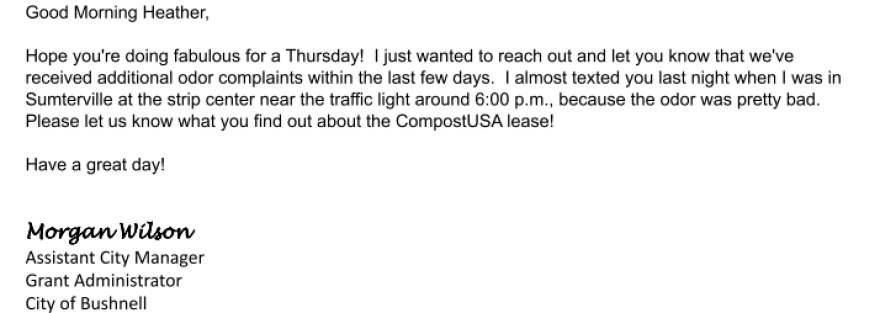
Trademark Metals didn’t respond to WUFT’s request for comment about its odor mitigation efforts.
Carter Williams, Chief Operating Officer for Organics Management, which owns Compost USA, said the facility has implemented multiple measures to reduce smells. Williams said the facility stopped accepting food waste in March 2023 because it “wasn’t there in terms of being able to do it successfully without creating some nuisances,” such as odors and birds.
The facility is piloting odor neutralizing systems to mitigate smells in addition to its normal efforts of ensuring arriving trucks are covered with tarps and quickly offloaded and mixing and covering biosolids with woody material to cap odors.
“Last night there were questions about what had changed,” Williams said, referencing the July 24 community meeting for the landfill. “The city asked us about that as well, and our answer is nothing. We haven't done anything different.” Compost USA will host a community meeting at 6:30pm on July 31 at the Bushnell Community Center.
As far as the landfill, Gudgel told residents at the meeting that the company was installing odor neutralizing equipment the next day. “ It's not our first choice of how we solve for odor,” he said, “but it is a tool that we can use.” The company plans to continue to expand its gas collection system and implement a renewable gas energy project within the next two to three years to repurpose the gas as fuel.
As the landfill continues operations, “ our commitment to you is that you do not smell it,” Gudgel said. “If you are smelling it, that is unacceptable and we take ownership of our part of that.”
FDEP requested information about the landfill’s gas collection system, flare and leachate evaporator on July 17 “to make a final compliance determination.” The landfill hadn’t yet responded to FDEP’s request as of July 25, but Gudgel confirmed a response is being drafted. The agency will review the information to determine if the landfill is in compliance or if enforcement action is necessary.
Until then, residents will continue to pull their shirts over their noses and cut their morning walks short to avoid the smell.
“I’ve been here for 30 something years and now with this, there's nowhere else we can leave,” said Tammie Sumner. “We're kind of trapped. We're trapped on our stinky, dirty diaper pile.”

